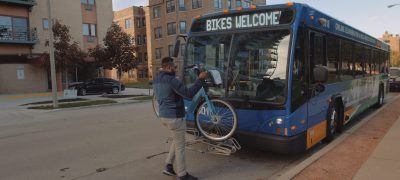
Hello Everyone,
Data sources and analysis are front and center as transit agencies and others decide when and how to operate in an ongoing COVID19 world. We are all asking if the curve has flattened yet. Should that curve be considered by State, by county or by city? Why is covid19 under control in crowded places like Seoul and Hong Kong, where people have continued to use transit, while some small cities and rural areas in the US are hotspots? How do we interpret numbers mentioned in news reports and in press conferences?
We at N-CATT are judicious consumers of data analysis. For a quick read about how to judge news with statistics and data analysis, we recommend reading Three Key Concepts for Interpreting Data in the Age of Coronavirus, a post advising reading covid19 reporting through the prisms of bias, variability, and lag. Here is a quick summary:
- Bias – “When reading a study or story with case statistics, it is more trustworthy if there is discussion of why the numbers might be biased up or down.” The blog post looks at what the covid19 numbers are based on in terms of who is tested.
- Variability – “The lesson is that for any statistic, it’s important to check the size of the population it’s based on, and whether multiple people have tried to measure it. For any result that is far outside what others have found, it’s good to be suspicious.” The blog post talks about the tendency for media to report on polling results at the extremes, sometimes called “publication bias.”
- Lag – “One key metric that tends to lag is number of coronavirus-caused deaths. Although many countries and cities try to produce daily death counts, those numbers are typically undercounts.” The problem in the fatality numbers is both lag in reporting time by health authorities and lag from the time of transmission until the virus has worked its way through an individual. If there is a death, that may occur weeks after transmission. “The answer to dealing with lag as a data consumer is pretty simple. Make sure to check the date of the estimate, and whether it is likely to be updated.”
Sheryl Gross-Glaser
Editor, N-CATT Tech News
Director, National Center for Applied Transit Technology
Community Transportation Association of America
grossglaser@ctaa.org
202.386.1669
N-CATT Webinars
Open Source Software and Open Data
May 21, 2020 at 2 p.m. Eastern – Open Source Software and Open Data – This webinar will provide the definitions of open source software and open data, and explain how they relate to demand-response transportation (DRT), including, but not limited to paratransit, microtransit, human services transportation, ridesourcing (aka ride hailing) taxis, and non-emergency medical transportation (NEMT). Speakers will discuss how the use of open source software can leverage resources beyond your agency, reduces the cost associated with procuring and operating DRT software and benefit from upgrades and enhancements at no additional cost.
Speakers will describe the use of open transit data to allow the public and entities outside of your agency to provide information and services beyond what is typically affordable by small agencies. Finally, the webinar will describe how open transit data is the foundation for mobility services such as one-call/one-click systems and Mobility as a Service (MaaS) (which will be explored in a future webinar). Click here to register.
GTFS Flex
June 17 at 2 p.m. Eastern – GTFS Flex
GTFS-flex promises a future with online “trip planning” for demand-responsive transportation, similar to the Google Transit feature and other trip planners that exist for fixed-route transportation. But what are the options now and how can I help my riders today?
This webinar on GTFS-flex will help you figure out exactly what you need to know about GTFS-flex, and what it offers to your agency. Presenters include Thomas Craig, CEO of Trillium and one of many architects of the GTFS-flex data specification, as well as Caroline Rodier of UC Davis and Jonathan Wade of Denver RTD. The webinar will cover GTFS-flex from a variety of angles, so whether you are a small rural transit agency with demand-responsive services, or a state DOT or MPO planner investigating mobility-as-a-service, or a vendor considering GTFS-flex implementation, this webinar will define the players and give concrete advice and next steps to public agencies in particular. To register, click here.
Framework for Technology Decisions
Archived webinar – Framework for Technology Decisions – This webinar presented a framework for considering and making technology decisions that is broadly applicable to different types of technologies, whether they are incremental or fundamentally new. Even as technology evolves, a framework structure remains useful to account for priorities, goals, and risks. Transit agencies can take the materials learned during the webinar to begin working through considerations they’ve been navigated for tech in their systems. (Aired on Apr. 15, 2020)
Opportunities
Inclusive Design Challenge
U.S. DOT opened the Inclusive Design Challenge, a competition seeking design solutions to make future automated vehicles more accessible to people with disabilities. They seek innovative design solutions that can enable people with physical, sensory, and cognitive disabilities to use automated vehicles to access jobs, healthcare, and other critical destinations. Proposals are due October 30.
NCMM Mobility Design Challenge Grants
The National Center for Mobility Management, with funding from the Federal Transit Administration, will be making Community Mobility Design Challenge 2020 grants to communities seeking innovative ways to address the personal wellbeing of community members that face transportation barriers to recreation and physical activities, healthy food, personal safety, economic opportunity, or community and peer support opportunities. The NCMM grants will enable multisector community teams to develop promising mobility solutions that are inspired and informed by the results of community research. Communities should be entering the Design Challenge with a clear, well-researched understanding of the needs in their community, not a proposed solution. The deadline for applications is July 15. Click here for information and a timeline that includes pre-application activities. A webinar is being hosted on May 14.
Tech Info from Fellow Technical Assistance Centers
NADTC Blog Addresses Data Storage and Transmission
The National Aging and Disability Transportation Center (NADTC) blog features a valuable post, entitled Demand Response Data Access & Communications Choices. The post written by Steve Yaffe, delves into data storage in the cloud and cellular and radio communications. There is practical information about the factors, both positive and limiting, that should inform decision making about what services to use.
National RTAP Web-Based Applications
The National Rural Transit Assistance Program (RTAP) has developed four web-based applications, which are convenient products designed for small rural transit agencies. These products are all free.
- Two-Variable Cost Allocation Calculator: As a requirement of reporting to the National Transit Database (NTD), public transit agencies must be able to provide expense information by different travel modes, jurisdictions, and service types. Transit agencies must also understand the costs of different services for managing federal and state grants as well as pricing and planning for new services. The Two-Variable Cost Allocation Calculator can help transit agencies make the process of cost allocation a little less daunting. Developed by Texas A&M Transportation Institute (TTI) and RLS & Associates, Inc., for National RTAP, the calculator is available as an MS Excel or MS Access application. Both versions provide the same level of specificity for data inputs and produce output reports for individual routes/services or groups of routes.
- GTFS Builder: Trip planning technology – the integration of transit route and schedule data on a map – enables riders to determine how they can utilize transit to go between points A and B. You might find the information you already collect moves your agency one step closer to having that technology. GTFS Builder helps you complete the final steps. National RTAP partnered with Transnnovation Inc., to produce GTFS Builder to help you create GTFS files to post on trip planning websites such as Google Transit. The GTFS Builder webpage includes videos and many images to help with the process of getting started.
- ProcurementPRO: Rural and Tribal grantees and State DOTs must adhere to Federal Transit Administration (FTA) procurement procedures. Using basic project information entered by the user, the ProcurementPRO program provides the required FTA clauses and certifications that must be included in procurement documents. The application also provides resources such as a procurement document template, check lists, and guidance for preparing procurement documents.
- Website Builder: Since 2011, Website Builder has allowed users to create and design websites that are hosted on the National RTAP server free of charge. In 2019, National RTAP released Website Builder 3.0 using customer feedback to make improvements. Website Builder 3.0 provides a basic template, simplified design functions, and new support resources. Those wishing to do more advanced work on their websites are still able to do so.
SUMC Shared & Electric Mobility Initiative
The Shared Use Mobility Center (SUMC) is co-leading a partnership for the California statewide Shared & Electric Mobility Initiative with the California Air Resources Board (CARB), the government agency charged with protecting the public from the harmful effects of air pollution and developing programs and actions to fight climate change.
Over the next two years, SUMC will serve as the co-manager of CARB’s Clean Mobility Options (CMO) program, directing $17 million to shared and electric pilot projects in low-income communities around the state. SUMC will co-manage the CMO program with partner CALSTART (which is not a California agency), serving as the technical lead with a focus on program design, technical assistance, and evaluation. Additional partners GRID Alternatives and the Local Government Commission will support a major statewide outreach effort to engage the public about these promising solutions to climate, transportation, and equity challenges.
Pilot project locations have not been selected yet.
What is MaaS and Why is it THE Hot Term?
Mobility as a Service, known as MaaS, is not in itself a technology; nor is it a defined transportation system. Rather MaaS is the technological enabling of a business model that, when complete, includes a comprehensive source of information about and payment for whatever transportation modes exist in a given area, such as transit, volunteer transportation services, or non-emergency medical transportation (NEMT), so that information, payment, scheduling and dispatch, can all be integrated on a common platform.
Universal MaaS Is NOT the Only Definition
A MaaS system should include whatever modes exist in a given area, be they fixed route or any type of demand-response. Sometimes called Universal MaaS, a term embraced by AARP, the “Universal” conveys the message that specialized transportation or assisted services are integrated into the MaaS ecosystem.
Universal MaaS, however, is not always what is when people use the term MaaS. For many, MaaS includes publicly available transportation, including transit, ridehailing, microtransit, and shared micromobility modes (such as bikeshare and scooters). The failure to embrace Universal MaaS is not necessarily intentional, but results from the fact that only a subset of transportation professionals are aware of the ins and outs of NEMT and human services demand-response modes, particularly outside of large cities and major metropolitan areas, or about the transportation challenges for people with disabilities and older adults.
MaaS is happening around the world and popping up in the US, at least in the form of introductory steps.
A note of caution: MaaS is a term that is currently abused and stretched to mean very different concepts. Because MaaS is the hot term these days, many tech vendors and app developers wish to be seen as operating under the MaaS umbrella, even if that means expanding that umbrella a bit far. By knowing the definition, one becomes an informed consumer who is able to determine whether a vendor is talking MaaS or something else.
What MaaS Means to the Consumer
MaaS can be defined either from the perspective of the consumer or the transportation provider. For the consumer, a true MaaS system means:
1. An app, a website, and/or a phone number that is (are) a source of information about what modes are available, including eligibility;
2. Prices of available modes for a particular trip, or type of trip;
3. Scheduling and payment for the trip – or series of trips; and
4. Real-time information, alerts or notifications.
A conventional way to think about MaaS for the potential rider is that “[r]ather than having to locate, book, and pay for each mode of transportation separately, MaaS platforms let users plan and book door-to-door trips using a single app. By answering the question of how best to get individual users where they’re going based on real-time conditions throughout the network, taking account of all the possible options and each user’s own preferences (for example, time and convenience vs. cost), and facilitating seamless mobile payment, MaaS becomes a user-centered mobility paradigm.” The Rise of Mobility as a Service, Deloitte Review (2017).
What MaaS Means for the Transportation Provider
For a transit agency or other transportation provider, MaaS is partly a philosophical approach to enabling a transportation network, partly a business model, and partly the technology interfaces for both transportation providers and rider that enables a MaaS system to become reality. MaaS assumes that transportation providers – be they transit, Uber, a social services agency, or a volunteer organization – view each other as part of one entirety rather than strictly as competitors. The airlines essentially made this transition when permitting usage of software systems to arrange flights. American and United Airlines, for example, are willing to enable customers to book flights through the common marketplace of online platforms even though these corporations compete on price, loyalty program perks, and other aspects of service.
For a transit agency and transportation provider, MaaS goes a step beyond one-call/one-click systems to provide one platform for entering transportation option information in a way that is easy, even automatic, for each provider, and that enables access online and through smartphones to the rider, with access to information, schedules, reservations, and payment – even bundled payment packages.
One-call/one-click systems provide the foundation information and capacity on which to build a MaaS platform. MaaS certainly can also incorporate a one-call operation with a human operator personally responding during a telephone conversation. However, the idea is to reduce the expense of a reservation and dispatch system that relies entirely on phone conversations.
Quick MaaS Education
The following resources explain the details of MaaS; stepping stones to MaaS; what MaaS systems look like and how they operate; and case studies. Below, please also find recent reports and sources of information that are updated on a regular basis.
MaaS Primers – NCMM
NCMM Brief – Mobility as a Service: Concept and Practice is a brief report that explains basic MaaS concepts, definitions, and the technology involved.
NCMM Blog – Four-part series
Part 1 – What is MaaS? – Defines MaaS and offers and overview of the MaaS philosophy and what it can provide transit providers and riders.
Part 2 – Mobility as a Service: First Steps – An exploration of the different levels of MaaS that can be adopted and the first steps that providers can take to start implementing MaaS.
Part 3 – Mobility as a Service: Further Integration – Discusses subscription packages and bundled payment platforms that enable payment regardless of mode through one centralized site or app.
Part 4 – Mobility as a Service: Full Integration – Explains how full integration involves the participation of the local governing structure to integrate MaaS as a core component of the transportation network and how the State of California is taking an early lead in investigating and planning for a MaaS network.
Universal MaaS and Case Study – AARP
AARP – MaaS information, video, and international case study. These resources focus on the Universal MaaS network established in Denmark, which operates in small urban and rural areas throughout the country.
AARP – Universal Mobility as a Service: A Bold Vision for Harnessing the Opportunity of Disruption explains in detail the way universal MaaS can assist the millions of non-drivers in the US, and how there is now a prime opportunity for MaaS because of the new transit technologies becoming available.
Living MaaS Information Sources
MaaS Alliance – International, public-private association that focuses on promoting and implementing MaaS. The MaaS Alliance maintains a MaaS map that displays where MaaS projects and systems exist across the globe.
APTA Mobility as a Service webpage – Blurbs and links to information about steps toward MaaS and MaaS projects that involve US transit systems.
Shared Use Mobility Center (SUMC) MaaS articles and posts – MaaS is a topic that appears frequently in SUMC publications, particularly in its newsletter.
MaaS Research
These reports offer in-depth information about components of MaaS, partnerships and coordination as a path to MaaS and to enable MaaS systems, integrating transit effectively with MaaS, and case studies.
- MaaS in rural areas – case Finland
- Opportunities in Mobility as a Service (2019)
- FHWA Global Benchmarking Program Report – Shared Use Mobility: European Experience and Lessons Learned (2018)
- Development of Transactional Data Specification for Demand-Responsive Transportation (2019)
- TCRP Synthesis 148: Business Models for Mobile Fare Apps (2020)
- TCRP Synthesis 140: Comprehensive Bus Network Redesigns (2019)
- Partnerships Between Transit Agencies and Transportation Network Companies (2019)
N-CATT on Social Media
No matter your social media venue preferences, N-CATT is there. We update our social media feeds several times a week and on a more than daily basis whenever there is pertinent news. On Twitter, especially, we are sharing Covid-19 transportation or related resources that fall outside the purview of N-CATT’s mission, but which significantly affect the many transit, transportation providers, local and state governments, and state DOTs, in particular, that we serve.
Please share your stories on Twitter about the brave men and women who are driving and keeping buses running, and otherwise providing public transportation. We are using the hashtag #COVID_TransitHeroes.
N-CATT on Facebook
View the N-CATT page on Facebook. N-CATT staff are posting information about and links to events and resources. These include events and resources of our partner technical assistance centers, the FTA, and national organizations.
N-CATT on LinkedIn
On the LinkedIn N-CATT page, we are sharing ideas, thoughts, and news, as well as information about N-CATT activities and products. LinkedIn is a wonderful forum for discussion because so many transportation thinkers, professionals, and managers participate in that venue. We are also engaging with the transportation technology sector, which is active on LinkedIn.
N-CATT Meows on Twitter
Find N-CATT meows at @TransitNCATT.
N-CATT’s Twitter feed and tweets continue to be dominated by COVID-19-related news and resources, but there has been a decided shift. Unlike the past couple of months, there is a reappearance of transit tech news unrelated to the pandemic. We are again seeing news about technology applications for transit use. N-CATT is also monitoring the increasing contribution of transit and automated vehicles for deliveries to help vulnerable individuals.
- #Volunteer transportation gets a boost with technology that matches volunteers with food deliveries.
- Contactless ticket kiosks are coming to @NJTRANSIT that are ADA accessible and promise to be faster and easier to use.
- North Carolina DOT launching a public-private partnership to use drones in coronavirus-related relief efforts. Drones will deliver food and critical medical supplies. Involves NCDOT’s Division of Aviation and private-sector partners.
- #Drones and AVs emerge as delivery vehicles and more during #COVID19. This is a crisis that is sparking a complete rethinking of what it means to be public or publicly available transportation. #autonomousvehicles #transit
- #Colorado has released an incredibly ambitious plan to introduce more #ElectricVehicles to help curb emissions. A big part of this plan involves to replacing the state’s cars and buses with electric, low-emission alternatives. #EVs
- Re-tweet: It’s Friday which means #MTGoodNewsTransit is back. We know community has always been a tenet of transit providers, but it seems more relevant now than ever. This week we highlight transit’s ability to innovate to support communities beyond transportation.
- @PTVGroup has released City in Motion, a visualization tool that takes transportation data to map out transit systems in action. This tool allows transit providers to better analyze and plan transit routes and micromobility options.
- Tech for #pwd must be accessible and inclusive. @UnitedSpinal is launching the Tech Action Initiative, and will focus on improving technologies like AI and #AutonomousVehicles to better serve people with disabilities.
- In an effort to push automated vehicle technology in a direction where it is accessible and widely in use, @calstart is launching a wide ranging, multi state and multi transit system #AV initiative.
- “For electric transportation to scale, the entire ecosystem needs to speak the same language. Today, there is little unification in terminology, metrics, and reporting.” Predicts consensus on metrics, standards consensus w/in few yrs. #EV #transit
N-CATT Transit Images
Transit Beyond Essential Workers
This video from Hong Kong shows how throughout the disruption of normal life, which initiated there in mid-February, transit has been well used and people are out and about on the streets. However, as the video clearly shows, people in Hong Kong are all wearing masks and performing frequent handwashing, sanitizing, and wearing gloves to protect themselves and others in a city where it is often impossible to practice social distancing once one leaves one’s apartment or place of work. Hong Kong is currently slowly returning to normal, with gatherings in public allowed of up to eight people (up from four), offices opening, and students returning to schools this month. These opening measures are being taken now that the city has not reported any local transmissions for more than two weeks and recorded zero cases for seven of the past 10 days,” according to Reuters.
CAT on the Bus
One Canadian transit jokester published a blog post in 2012 announcing that a transit agency created a cats-only, cats-driven bus route. The O dot News Update reported “”We just saw a cat-bus veer off the road after a bird landed on the windshield, and the cat-driver got distracted.” said Ottawa Transportation Committee Head Jean Silvay, who thinks the new cat bus program could also escalate in terms of operational costs. “One cat bus driver costs upwards of $200,000 to properly train to operate a bus, and these dollars I think could be better spent on human bus services.” Silvay exclaimed.” The fare? Three cat licks. Costs are a concern, but feline feedback is positive; lots of meow comments. No reports since.



